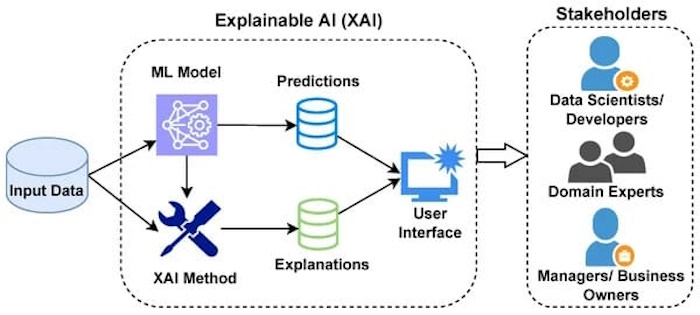 Explainable AI (XAI)
Explainable AI (XAI)
Have you ever wanted an explanation from AI? That's the essence of XAI.
Related: AI Ethics | Bias | Data Privacy
Explainable AI (XAI) is a set of techniques, principles, and processes that enable AI developers and users to comprehend AI models and their decisions. XAI refers to AI methods that render transparent the decision-making processes of machine learning models so they can be understood by humans. As AI becomes more advanced, it's crucial to understand how algorithms arrive at a result.
XAI aims to address the "black box" problem in AI, where complex models such as deep learning neural networks, provide little insight into how the AI operates. It aims to provide an understanding of why an AI model behaves the way it does in order to reach certain decisions.
The main focus of XAI is to make the reasoning behind AI algorithms' decisions or predictions more understandable and transparent. XAI seeks to explain the data used to train the model, the predictions made, and the usage of the algorithms. It essentially requires drilling into the model to extract the reasons behind its behavior.
A corollary concept to Explainable AI is Interpretable AI. While often used interchangeably, Explainable AI and Interpretable AI have very different meanings. XAI explains the AI decision-making process in an understandable way, while interpretable AI refers to the predictability of a model's outputs based on its inputs, and is thus used to understand an AI model's inner workings.

 Key Objectives of XAI
Key Objectives of XAI
- Transparency: Enable users to understand how AI systems operate.
- Accountability: Provide reasoning for AI decisions to ensure ethical compliance.
- Trust: Build confidence among users by clarifying how decisions are made.
- Fairness: Identify and mitigate bias in AI models.
- Compliance: Support adherence to regulations by offering explanations.
 Why is XAI Important?
Why is XAI Important?
- Ethical Decision-Making: Helps detect and prevent discriminatory or biased decisions.
- Legal Requirements: Regulatory frameworks often mandate that AI decisions be explainable such as GDPR's right to an explanation.
- Safety and Reliability: In industries like healthcare or autonomous driving, understanding AI decisions is critical for user safety.
- User Trust: Transparency fosters acceptance and trust in AI solutions.

 Principles of AI Ethics
Principles of AI Ethics
- Explanation: A system should provide evidence or reasoning for its outputs and processes.
- Meaningful: Explanations should be understandable to the intended users.
- Accuracy: Explanations should accurately reflect the reasons for generating the output and the system's process.
- Knowledge Limits: A system should only operate under conditions for which it was designed and when it reaches sufficient confidence in its output.
 XAI Techniques
XAI Techniques
- Feature Attribution: Identifies which features of the input most influenced the output. For example: SHAP (Shapley Additive Explanations) and LIME (Local Interpretable Model-Agnostic Explanations).
- Model Simplification: Creates simpler models to approximate complex ones. This can be achieved with decision trees approximating neural networks.
- Visualization Tools: Heatmaps and attention maps show regions of importance in visual models.
- Counterfactual Explanations: Shows how changing inputs could lead to different outputs.
- Self-interpretable models: These models are themselves the explanations and can be directly read and interpreted by a human.
- Post-hoc explanations: These are techniques applied after the model has been trained to understand its behavior.
"By far, the greatest danger of Artificial Intelligence is that people conclude too early that they understand it."
 Applications of XAI
Applications of XAI
XAI is used in many industries including healthcare, finance, and legal
- Autonomous Driving: Understanding AI decisions is critical for user safety. If a driver can understand how and why the vehicle makes its decisions, they will better understand what scenarios it can or cannot handle.
- Defense: Ensuring accountability in AI-driven military systems. DARPA is developing XAI in its third wave of AI systems.
- Healthcare: Interpreting diagnostic models and predicting patient outcomes. Facilitates shared decision-making between medical professionals and patients.
- Finance: Clarifying credit approval processes and fraud detection systems. Helps meet regulatory requirements and equips analysts with the information needed to audit high-risk decisions.
- Legal: Auditing AI-based sentencing recommendations.
 Benefits of XAI
Benefits of XAI
XAI provides more accountability and transparency in AI systems
XAI can help developers ensure that systems work as expected, meet regulatory standards, and allow those affected by a decision to understand, challenge, or change the outcome. It also improves the user experience by helping end-users trust that the AI is making good decisions on their behalf. Here are some additional benefits:
- Builds trust: Individuals might be reluctant to trust an AI-based system if they can't tell how it reaches a conclusion. XAI is designed to give end users understandable explanations of its decisions.
- Improves the overall system: With added transparency, developers can more easily identify and fix issues.
- Identifies cyberattacks: Adversarial machine learning attacks attempt to fool or misguide a model into making incorrect decisions using maliciously designed data inputs. An adversarial attack against an XAI system would reveal the attack by showing unusual or odd explanations for its decisions.
- Safeguards against bias: XAI aims to explain attributes and decision processes in machine learning algorithms. This helps identify biases that can lead to poor outcomes related to training data quality or developer biases.
 Challenges of XAI
Challenges of XAI
- Performance: There is a trade-off between accuracy and interpretability. Simplifying models may reduce their performance.
- Model Complexity: Some advanced models resist straightforward interpretation.
- User Understanding: Technical explanations might not be meaningful to laypersons.
- Ethical Ambiguity: Lack of a universal standard for "acceptable" explanations.
 Links
Links
builtin.com/artificial-intelligence/explainable-ai
techtarget.com/whatis/definition/explainable-AI-XAI
ibm.com/think/topics/explainable-ai
insights.sei.cmu.edu/blog/what-is-explainable-ai/
en.wikipedia.org/wiki/Explainable_artificial_intelligence
edps.europa.eu/system/files/2023-11/23-11-16_techdispatch_xai_en.pdf
c3.ai/glossary/machine-learning/explainability/